Uber’s arrival in Kenya in January 2015 was a turning point for the country’s urban transport sector. The American ride-hailing app made it possible to summon a car from a smartphone, see a fare estimate before boarding, and pay by cash or card.
At that time, it was the first taste of tech-enabled convenience for riders in Nairobi. The service quickly spread beyond Nairobi to Mombasa and Kisumu. Over the past decade, Uber has influenced how Kenyans think about taxis, forced regulators to amend transportation laws, and created new earning opportunities for thousands of drivers (Uber declines to share how many drivers work on its platform in Kenya).
Uber’s growth coincided with fare reductions, a high commission structure, and heavy driver protests. The company has been sued, probed by the government, and experienced repeated strikes.
It now enters its second decade with Uber Safari, a new product that links its platform to Nairobi’s tourism economy. The launch has been met with praise and unease, signaling that many drivers and policymakers still have mixed feelings about Uber’s place in Kenya’s transport system.
Legal and regulatory changes
When Uber entered the market, it was treated as a technology platform rather than a transport operator. This early classification gave it room to grow without being subject to the strict licencing requirements faced by traditional transport businesses.
Local taxi associations pushed back, accusing Uber of unfair competition and calling for a level regulatory field. In 2015 and 2016, there were violent attacks on Uber drivers, including reports of vehicles being vandalised near popular pick-up points.
Amidst these issues, regulatory response took years to form. By 2019, the National Transport and Safety Authority (NTSA) had created a licencing regime for digital taxi operators, which required them to register, share trip data with regulators, and enforce a commission cap.
Court cases by drivers further forced Uber to revise its contracts. A key ruling by the High Court held that Uber BV (its Dutch subsidiary) in Amsterdam could not avoid responsibility for fare decisions in Kenya. This clarified that drivers were in a contractual relationship with Uber Kenya and that any fare or commission change had to be fair and transparent.
Taxation has been another area of tension. The Finance Act introduced digital service tax in 2021 and later e-TIMS compliance in 2024, forcing Uber and its drivers to register for PINs and submit electronic invoices. While this improved tax compliance and gave the Kenya Revenue Authority (KRA) better visibility into ride-hailing income, many drivers say it increased their administrative and financial burden at a time when fuel prices were already eroding their margins.
Consumer protection rules also changed the way Uber operates. After a 2025 probe by Common Market for Eastern and Southern Africa’s (COMESA) competition authority, Uber was compelled to revise its terms so that disputes are handled under Kenyan law, not Dutch law. The same order required Uber to clearly communicate price surges and obtain consent from riders before adjusting fares mid-trip.
Drivers’ experiences and repeated protests
The promise of Uber as a steady income stream drew thousands of drivers onto the platform. Many took loans or entered lease-to-own arrangements to acquire vehicles. At first, generous incentives and high base fares made it possible to earn comfortably. But fare reductions in 2016 and a 25% commission rate quickly strained drivers’ finances. Net earnings fell below what many needed to repay loans and maintain their cars.
At some point during the COVID-19 pandemic, drivers staged sit-ins outside Uber’s offices in Nairobi and occasionally switched off the app to disrupt service. Their demands included reducing commission to 10 or 15%, increasing fares to reflect fuel and maintenance costs, and allowing more flexibility in how drivers set prices.
Uber responded by introducing a tipping feature, occasional fare adjustments, and maintenance discounts, but many drivers say the changes did not address the underlying problem that most trips were still unprofitable after expenses.
There is an ongoing debate about whether driving for Uber can be a main source of income. A 2025 IDinsight study found that Kenya’s platform drivers often work over 66 hours per week to break even.
Earnings fluctuate based on demand, traffic, and competition from other platforms such as Bolt, Little, and Faras. While some drivers report making enough to sustain their households, others say the model pushes them into debt and forces them to work dangerously long hours.
“Most of the Uber cars on the road are financed through loans. Drivers often work long hours just to cover monthly payments, because if they fall behind, the cars are repossessed,” Paul Sakwa, a former ride-hailing driver who now uses an electric bike, told on Wednesday.
The protests have rarely translated into lasting policy change. The NTSA’s 18% commission cap, introduced in 2022, was seen as a win for drivers but was only partially implemented, with platforms continuing to charge more through loopholes. Labour unions have tried to organise drivers into cooperatives and bargaining groups, but high turnover and oversupply of drivers make collective action difficult to sustain.
What Uber Safari represents
For its tenth anniversary in Kenya, Uber launched Uber Safari on Tuesday, a product that allows users to book guided tours of Nairobi National Park directly through the app for KES 25,000 ($194) during the day or KES 40,000 ($311) at night. Riders can choose day or night packages, reserve in advance, and get picked up in safari-ready vehicles.
The idea is to merge urban ride-hailing with the tourism sector, creating a new revenue stream for licensed tour operators and giving Uber access to a premium segment.
“With Uber Safari, riders can choose between two unique offerings: a Day Safari or a Night Safari, both through Nairobi National Park – the first of its kind available through the Uber app. Using Uber Reserve, riders can pre-book their adventure directly in the app, then be picked up in a fully licensed, safari-ready Land Cruiser operated by licensed tour companies,” Uber said in a statement seen by .
Despite this, only drivers with special vehicles and partnerships with fleet operators can participate, leaving out the bulk of ride-hailing drivers.
Some see this as a missed opportunity, arguing that the company should first address earnings on regular trips before branching into tourism. Others worry that Uber Safari will create new pricing pressures by introducing its algorithm-driven approach to a sector that traditionally allows operators to negotiate higher margins.
“No wonder they don’t initially show the price on the app. KES 25,000 is enough for a holiday in Diani,” Kiruti Itimu, a media executive in Nairobi, told on Wednesday.
A tour operator, who requested anonymity and runs an office in Nairobi’s Westlands, told that they already face high licencing fees and compliance costs, and fear Uber’s entry could trigger a race to the bottom in safari pricing. Supporters argue that Uber Safari could expand the market by attracting younger, tech-savvy tourists who might not book a traditional tour.
A half-day trip to the park typically costs between $43 and $138 per person with a tour company or park-operated vehicle, significantly lower than Uber’s rates.
A mixed decade, and what comes next
Uber’s first ten years in Kenya have been marked by undeniable growth and equally undeniable conflict. It pioneered digital ride-hailing, expanded payment options, and gave many urban residents safer and more predictable transport.
It also expanded into food delivery, motorcycle taxis, and low-cost services such as Chapchap, changing how logistics and mobility work in Kenyan cities.
But the decade has also been defined by disputes over fairness. Drivers have protested fare cuts, taken Uber to court, and lobbied for regulatory protection. Regulators have responded with piecemeal reforms, some helpful, others burdensome. Passengers have benefited from lower fares and better service, but often at the expense of driver welfare.
Uber can double down on growth by finding new markets like tourism and continuing to optimise for riders, or it can work toward driving a more sustainable livelihood by sharing more revenue with its core workforce.
Suppose the last ten years are any guide. In that case, the tension between profitability, driver welfare, and regulatory compliance will continue to influence Uber’s and, by extension, other ride-hailing platforms in the Kenyan story.
Mark your calendars! Moonshot by is back in Lagos on October 15–16! Meet and learn from Africa’s top founders, creatives & tech leaders for 2 days of keynotes, mixers & future-forward ideas. Get your tickets now: moonshot..com










